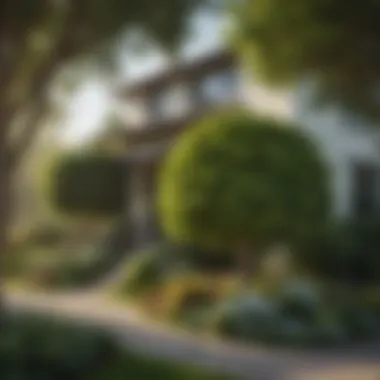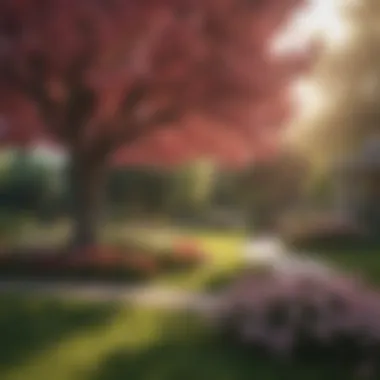Selecting the Ideal Trees for Your Front Yard


Intro
Choosing the right trees for your front yard requires careful thought and consideration. This decision influences not just the aesthetic appeal of your home but also the environmental impact. Several factors must be considered, such as local climate conditions, available space, and the specific characteristics of various tree species. Homeowners aim to create inviting and functional outdoor spaces. Understanding how to select the ideal trees plays a crucial role in achieving that goal.
Design Inspirations
Creating a harmonious front yard often begins with selecting trees that resonate with your design vision. Considerations like trending styles and color palettes shape the overall appeal of your landscape. Different tree forms can complement or contrast with the architectural style of your home.
Trending Styles
The trend toward naturalistic gardens encourages the selection of native trees. These trees thrive in local conditions and support local wildlife. Furthermore, minimalist landscapes have gained popularity, leading many homeowners to choose single-specimen trees or small groups that serve as focal points. Wider canopies can provide shade and serenity, making them an excellent choice for areas where families gather.
Color Palettes
Tree selection is not just about shape; it's also about color. Spring-flowering species such as Cercis canadensis, known as Eastern Redbud, can infuse your yard with vibrant hues. In contrast, deciduous trees like Acer rubrum, or Red Maple, offer stunning fall colors. An aesthetic strategy that combines evergreen and deciduous trees will ensure year-round visual interest.
Maintenance and Upkeep
After selecting trees, they require attention to thrive. Maintenance enhances aesthetic appeal and longevity.
Seasonal Maintenance Checklist
- Spring: Fertilize to support growth; check for pests and diseases.
- Summer: Water regularly; prune any dead branches.
- Fall: Clean up fallen leaves; mulch to retain moisture.
- Winter: Inspect branches for snow damage; plan for spring planting.
Cleaning and Organization Tips
Encouraging a tidy landscape can be achieved through regular raking and trimming. Plan for seasonal cleanups to avoid clutter and promote healthier trees. Many homeowners find it beneficial to group similar tasks, making maintenance efficient.
"Selecting the right trees is essential for any homeowner. This impacts not just appearance but also environmental health."
Understanding Front Yard Tree Selection
Choosing the right trees for your front yard is an essential part of landscaping. Trees not only offer aesthetic appeal but also provide numerous ecological benefits. Selecting the best species suitable for your specific environment can enhance the overall beauty of your property, increase property value, and contribute positively to local wildlife.
When you understand the unique characteristics of various tree species, you can make informed decisions. Each type of tree has its strengths and weaknesses, which must be assessed relative to your yard's conditions and your personal preferences. Thus, grasping the fundamentals of tree selection is crucial.
The Role of Trees in Landscaping
Trees play a key role in landscaping. They add shade, privacy, and beauty to outdoor spaces. By integrating trees into your landscape, you establish a sense of structure and coherence. Trees can create focal points or serve as background elements. Their canopies contribute to cooler environments during warmer months, providing relief from heat.
Additionally, trees can enhance the ecological health of the area. They absorb carbon dioxide, filter pollutants, and produce oxygen. Wildlife, too, benefits from trees, as they provide essential habitats. Therefore, incorporating trees into your front yard goes beyond mere aesthetics.
Factors to Consider Before Planting
Selecting the right trees involves several important factors. Here we discuss three critical aspects that should guide your selection process.
Space Availability
Space availability is pivotal when choosing trees for your front yard. It's important to assess how much room is available for the trees to grow both upward and outward. Trees have various growth habits; some might become large and require ample space. Ensuring adequate space contributes to a healthy tree growth and reduces competition with nearby plants. Too little room can lead to stress on the tree, impacting its health.
A major contribution of space availability is allowing room for the tree's root system. Trees with restricted root systems can develop health issues, making them less attractive in the long run. Therefore, it is beneficial to consider how much land you can afford to devote to tree planting.
Climate Considerations
Climate considerations are also essential in selecting the right trees. Different species thrive in different climatic conditions, which include temperature range, rainfall patterns, and seasonal changes. Understanding the climate of your region will guide you in selecting trees that are more likely to flourish.
For instance, choosing heat-resistant varieties in warmer areas can prevent trees from suffering during drought spells. Additionally, frost-sensitive trees will not survive in areas with harsh winters. Therefore, selecting species that align with your local climate is advantageous and increases the chances of successful growth.
Maintenance Requirements
Maintenance requirements are a key aspect of tree selection. Different trees have varying needs for care, including watering, pruning, and fertilizing. Selecting lower-maintenance species might be more appealing for busy homeowners who prefer not to spend significant time tending their yards.
Moreover, higher-maintenance trees can involve additional costs, both in time and resources. Understanding your commitment to maintenance will help you select trees that match your lifestyle. This consideration assists in preserving the appearance and health of the trees while preventing potential frustrations associated with demanding options.
"Informed choices in tree selection can lead to beautiful landscapes that thrive without overwhelming the homeowner."
Types of Trees to Consider
When selecting trees for your front yard, understanding the various types significantly impacts the aesthetics and functionality of your landscape. Each type has distinct characteristics and benefits that contribute to the overall appeal of your property. The choice of tree type often influences space utilization, seasonal interest, and the surrounding environment.
Deciduous Trees
Characteristics


Deciduous trees lose their leaves during winter, creating an impactful seasonal change. This characteristic provides a unique visual experience as the foliage transitions from lush green to vibrant autumn hues before dropping off. Their height and broad canopy can offer significant shade during the warmer months. A key trait of deciduous trees is their ability to improve light penetration in winter, which can be beneficial for other plants in your garden.
Benefits
Deciduous trees can enhance air quality, offering oxygen while absorbing pollutants. They also help in regulating temperatures, providing shade in summer and allowing sunlight in winter. Additionally, these trees can be aesthetically pleasing, adding color and texture to your landscape. Their fallen leaves can enrich soil quality when composted, presenting an eco-friendly advantage.
Popular Species
Some popular deciduous tree species include the Maple, Oak, and Birch. Maples are known for their stunning fall colors and are relatively low maintenance. Oaks are robust, providing ample shade and a habitat for wildlife. Birches are not only attractive but also drought-resistant, making them a favorable choice in various climates.
Evergreen Trees
Characteristics
Evergreen trees maintain their foliage year-round, ensuring consistent greenery in your yard. This characteristic offers visual interest during all seasons. These trees can vary significantly in size and shape, providing versatility in design. Their needles can also serve as windbreaks, protecting the yard from harsh weather.
Benefits
The presence of evergreen trees can enhance privacy and noise reduction in residential areas. They are typically more resilient to pests and diseases, reducing the maintenance needed. Furthermore, these trees can create a dramatic backdrop for seasonal decorations and enhance the overall aesthetic all year round.
Popular Species
Common evergreen species include the Pine, Spruce, and Arborvitae. Pines are adaptable to different soil types and known for their tall structure. Spruce trees provide a classic conical shape and are often used in holiday decorations. Arborvitae can be shaped easily and used for privacy screens.
Flowering Trees
Characteristics
Flowering trees are celebrated for their beautiful blossoms and can significantly improve the visual appeal of your yard. Their bloom period varies by species, infusing your landscape with colors at different times of the year. This characteristic can provide a striking backdrop for your home during the flowering season.
Benefits
In addition to aesthetics, flowering trees can attract pollinators such as bees and butterflies, enhancing biodiversity in your yard. They can also provide fragrance, adding an olfactory component to your outdoor experience. The seasonal beauty can increase property value and enhance curb appeal.
Popular Species
Notable flowering species include Cherry Blossom, Dogwood, and Magnolia. Cherry Blossoms are especially admired for their vibrant pink and white flowers. Dogwood trees are also moderately sized and adaptable to various conditions. Magnolias, with large, fragrant flowers, can serve as stunning focal points in any landscape.
Fruit Trees
Characteristics
Fruit trees are unique as they not only provide aesthetic value but also have edible yields. They come in various sizes and types, allowing for flexibility in planting locations. Their characteristics can vary greatly depending on the climate and space available in your front yard.
Benefits
One of the main advantages of fruit trees is their dual purpose. They can enhance the landscape with beautiful blooms while also providing fresh produce right from your yard. This feature promotes sustainable living and offers a sense of achievement that comes from growing your own food.
Popular Species
Common fruit tree species include the Apple, Pear, and Peach. Apple trees are known for their adaptability and resilience, while pear trees can offer a more refined aesthetic and delicious fruit. Peach trees, in contrast, can provide beautiful pink flowers and are considered a favorite among homeowners looking for both beauty and function.
Choosing the right type of tree is crucial in designing a landscape that is not only beautiful but also functional. By understanding the distinct characteristics and advantages of each tree type, homeowners can create a front yard that meets their needs and complements their neighborhood.
Evaluating Popular Tree Varieties
Evaluating popular tree varieties is crucial for homeowners aiming to enhance their front yard. Selecting the right type of tree can significantly impact the overall aesthetic and functionality of the landscape. This section helps readers understand specific tree varieties that are suitable based on factors like growth habits, seasonal changes, and environmental conditions. A well-chosen tree can not only elevate the visual appeal but also offer benefits such as shade, wildlife habitat, or fruit production. Understanding these aspects allows homeowners to tailor their selections to personal preferences as well as regional characteristics.
Maple Trees
Maple trees are well-regarded for their stunning fall color. They come in various species, including the Sugar Maple and Red Maple, each offering unique characteristics. Sugar Maples provide vibrant yellow and red foliage, while Red Maples have brilliant red leaves.
Benefits of maple trees include:
- Strong shade coverage due to their broad canopies
- Enhanced soil quality through leaf drop, enriching the earth
- Adaptability to different soil types
Considerations include their need for sufficient space as they can grow quite large. They are also sensitive to drought, requiring regular watering during dry spells.
Oak Trees
Oak trees are a symbol of strength and endurance. Varieties like the White Oak and Red Oak are favored for their majestic stature. Oak trees support a wide range of wildlife, providing acorns that benefit birds and mammals.
Benefits of planting oak trees are:


- Longevity; they can live for hundreds of years
- Extensive root systems that stabilize the soil and prevent erosion
- Year-round interest with seasonal foliage changes
Considerations should include their growth rates, as oaks can take time to mature. Space is also a vital factor, as they can grow quite wide.
Crape Myrtle
Crape Myrtle is a flowering tree cherished for its colorful blooms and long flowering season. Varieties range from dwarf types, which fit smaller spaces, to larger ones suited for open areas. Their vibrant flowers can range from white to deep purple, providing visual interest throughout the summer.
Benefits of Crape Myrtle include:
- Drought tolerance once established
- Low maintenance, with fewer pest issues compared to other trees
- Attractive bark that peels away in layers, adding texture to the landscape
Considerations include their susceptibility to powdery mildew in humid areas. Additionally, proper placement is essential to prevent overcrowding.
Cherry Blossom Trees
Cherry Blossom trees are famous for their exquisite spring blooms. Varieties such as the Yoshino Cherry and Kwanzan Cherry produce stunning flowers that attract many admirers. They can create picturesque scenes in the spring, drawing visitors and elevating the neighborhood appeal.
Benefits of Cherry Blossom trees consist of:
- Eye-catching beauty that enhances front yards
- Short lifespan but quick growth for immediate impact
- Cultural significance in many regions, encouraging community appreciation
Considerations include the need for ample sunlight and well-drained soil. They may also require attention to prevent pests and diseases.
Choosing the right tree variety can transform your front yard, creating spaces for relaxation, enjoyment, and aesthetic pleasure.
Planting and Care Guidelines
Planting and caring for trees in your front yard is a critical aspect of maintaining a healthy and aesthetically pleasing landscape. This section outlines essential guidelines that ensure the longevity and vitality of your trees. Proper preparation, planting techniques, and ongoing care contribute significantly to the successful establishment of trees in any yard. Understanding these guidelines helps homeowners make informed choices that align with their gardening goals and local conditions.
Site Preparation
Soil Testing
Soil testing is a fundamental step in preparing the site for tree planting. It involves analyzing the soil's pH, nutrient content, and overall health. This information enables homeowners to determine if the soil is suitable for the selected tree species. The key characteristic of soil testing is its precision in diagnosing soil health. This makes it a beneficial choice for ensuring your trees have the proper growing conditions. A unique feature of soil testing is the ability to identify nutrient deficiencies or toxic levels of certain chemicals. Understanding these elements can guide decisions about soil amendments and tree selection, minimizing the risk of poor growth or even tree death.
Amending Soil
Amending soil is another critical component of site preparation. This process involves adding organic materials or nutrients to improve soil quality. The key characteristic of soil amendment is its ability to enhance soil structure, drainage, and nutrient retention. This makes it a popular choice for achieving optimal growth conditions. One unique aspect of soil amending is the use of compost, which not only provides nutrients but also promotes beneficial microbial activity in the soil. This can lead to healthier trees that are more resilient against diseases. However, it's essential to be cautious; adding the wrong materials can harm plant growth.
Planting Techniques
Depth Considerations
Depth considerations are crucial when planting a tree. Planting at the correct depth affects the tree's stability and root development. The essential aspect of depth is that it directly influences the tree’s long-term health. Planting too deep can suffocate roots, while planting too shallow can lead to instability. A unique feature of proper depth is ensuring that the root flare is visible above the soil surface. This practice allows for better oxygen exchange and root growth. However, improper depth can cause significant challenges for tree establishment, ultimately affecting its survival.
Spacing Requirements
Spacing requirements are vital factors in tree planting that influence overall growth and health. This aspect pertains to the distance between trees, which can affect sunlight access, air circulation, and nutrient competition. A key characteristic of spacing is that it allows each tree room to grow without competing for resources. Flawed spacing can lead to overcrowding, increasing the likelihood of disease transmission between trees. It can also limit the trees' ability to develop their complete form. Homeowners should research the mature size of their chosen trees to effectively plan spacing.
Maintenance Practices
Watering Needs
Watering needs of new trees are critical for ensuring they establish well in their new environment. Newly planted trees require consistent and adequate watering to promote root growth. The primary characteristic of watering is that it helps trees cope with transplant shock. Without proper moisture, trees may struggle to adapt. A unique advantage of understanding watering needs is that homeowners can develop a routine based on the tree species and local climate. Over-watering can be damaging, too, leading to root rot or other moisture-related problems.
Pruning Guidance
Pruning is an essential part of tree maintenance that aids in shaping and health management. Proper pruning keeps trees structurally sound and reduces the risk of disease. The key characteristic of pruning is that it encourages healthy growth patterns by removing dead or diseased branches. This technique enhances air circulation and light penetration, both crucial for a tree's overall well-being. However, incorrect pruning can lead to wounds that invite pests. Homeowners must learn proper techniques or consult professionals for guidance.
Fertilization
Fertilization plays a significant role in tree health and vitality. It involves adding nutrients to the soil to support healthy growth. The key characteristic of tree fertilization is its ability to mitigate nutrient deficiencies. This practice is especially beneficial for young or transplanted trees, as they might be under stress from their new environment. A unique feature of fertilization is that it should be done during the growing season when trees can effectively absorb nutrients. However, over-fertilization can cause harm, leading to poor growth or environmental impact.
Proper planting and care practices can significantly enhance the growth potential and health of trees, transforming your front yard into a flourishing landscape.
Environmental Benefits of Tree Planting
Selecting the right trees for your front yard goes beyond aesthetics. The environmental benefits they provide can significantly enhance your local ecosystem. This section delves into how trees improve air quality, mitigate urban heat, and support diverse wildlife. Each of these aspects contributes not just to a more beautiful landscape, but also to a healthier home environment.
Air Quality Improvement
Trees play a vital role in enhancing air quality. They absorb carbon dioxide, a key greenhouse gas, and release oxygen through photosynthesis. This natural process helps combat climate change. Additionally, trees filter pollutants such as sulfur dioxide, ammonia, and nitrogen oxides from the air. This filtration process occurs primarily through leaf surfaces.


Studies show that urban areas can benefit tremendously from increased green spaces. A mature tree can absorb up to 48 pounds of carbon dioxide per year. To illustrate:
- Air Quality Metrics: Trees can lower the concentration of harmful particulates in the air.
- Temperature Regulation: They help cool the surrounding air, which also impacts overall health.
Incorporating trees in your front yard not only beautifies your home but also contributes significantly to local air quality.
"The benefits of trees extend far beyond stunning views. They purify the air and create a sanctuary for healthier living."
Urban Heat Reduction
Urban areas, often termed 'heat islands', experience significantly higher temperatures due to extensive concrete and asphalt surfaces. Trees offer a natural remedy. They provide shade, reduce heat, and thus can help lower energy consumption for cooling purposes.
- Shade Application: Properly placed trees can block sunlight from hitting your home, reducing the need for air conditioning.
- Evapotranspiration: The process of trees releasing water vapor also cools the air, which can combat heat buildup in your front yard.
- Surface Temperature Control: Tree canopies lower ground surface temperatures, further alleviating urban heat.
Even a few strategically placed trees can make a notable difference in temperature control, making your yard more enjoyable during hot months.
Wildlife Habitat Support
Integrating trees into your front yard creates vital habitats for various species. Trees provide food, shelter, and nesting sites for birds, insects, and other wildlife. Consider this impact:
- Food Source: Many trees yield fruits, nuts, and seeds, attracting various species.
- Nesting Areas: Birds and small animals rely on mature trees for safe places to build nests and raise young.
- Biodiversity Stimulation: A diverse range of trees can support a richer ecosystem.
By selecting a mix of native trees, you not only enhance the beauty of your yard but also encourage a thriving wildlife community that enhances biodiversity. Such environments promote ecological balance and contribute to the overall health of the local ecosystem.
Common Challenges in Tree Growth
Selecting trees for your front yard goes beyond mere aesthetic considerations. Understanding the challenges trees face is crucial for ensuring their longevity and health. Trees in urban and suburban settings encounter a range of obstacles that can hinder their growth. Identifying and addressing these challenges leads to better tree management, which ultimately contributes to a vibrant landscape.
Pests and Diseases
Identification
Identifying pests and diseases early is essential for maintaining tree health. Common indicators of pest infestations include leaf discoloration, unusual growth patterns, and visible insects. Regularly inspecting trees helps to catch problems before becoming severe. Knowledge of local pests is necessary, as certain regions may harbor specific threats. A key benefit of understanding pest identification is that it empowers homeowners to take proactive measures.
For instance, aware of signs such as chewed leaves can lead to prompt action, preventing further damage. However, misidentification can lead to unnecessary treatments, wasting time and resources. Thus, gaining knowledge on identification can greatly enhance tree care efficiency.
Management Techniques
Effective management techniques are vital to mitigate the impact of pests and diseases on trees. Integrated Pest Management (IPM) is a widely recommended approach, combining biological, cultural, and chemical practices. This method is beneficial as it encourages eco-friendly solutions while minimizing pesticide use.
A standout feature of IPM is its adaptability to specific pest issues. For example, introducing natural predators can effectively control pest populations. One downside is that effective management often requires a thorough understanding of local ecosystems, which may not always be accessible to homeowners. Thus, while this technique has clear advantages, its implementation demands a bit of knowledge.
Environmental Stresses
Drought
Drought is a significant environmental stressor that affects tree health and growth. Trees suffering from insufficient water can exhibit wilting leaves, stunted growth, or even die back if conditions persist. Understanding the characteristics of drought-affected trees is crucial for timely intervention.
A notable feature of discussing drought is that it encourages homeowners to implement preventative measures, such as mulching to retain soil moisture. The advantage is not only preserving tree health but also reducing water consumption over time. However, severe drought can lead to long-term damage if trees do not receive adequate care in time.
Pollution
Pollution presents another factor contributing to tree stress. Urban environments expose trees to various pollutants that can affect their health, including vehicle emissions and industrial discharge. Recognition of pollution's impact is vital. For example, foliage affected by air pollution may show signs of damage through leaf burn or discoloration.
Understanding pollution stress can drive the need for selecting more resilient tree species in affected areas. While this knowledge aids in mitigating harm, it is critical to remember that restoring polluted environments may take time. Thus, choosing the right species and enhancing urban conditions are essential for healthy tree growth.
Epilogue: Making the Right Choice
Selecting the right trees for your front yard is a crucial step in achieving a harmonious landscape. This decision impacts not only the aesthetic appeal of your home but also various environmental factors. Trees can enhance property values, improve air quality, and provide shade, all while contributing to the local ecosystem. Given the myriad of options available, recognizing the specific needs of your space is essential.
Considerations such as climate compatibility, available space, and maintenance needs should guide your selection process. It's essential to envision how the tree will grow over time. A tree that may look small now could cast significant shade or block light as it reaches maturity. Therefore, a fundamental understanding of tree growth habits and local environmental conditions is vital for long-term satisfaction.
Furthermore, the ecological contributions of trees cannot be overlooked. Reputable trees help in cooling urban temperatures, fostering biodiversity, and providing food and shelter for wildlife. They serve functional purposes while enriching community aesthetics. Your chosen trees should align with both your landscaping objectives and sustainability goals.
"The beauty of nature lies not just within its aesthetics, but also in its functionality and ecological balance."
Regular maintenance practices like pruning, watering, and monitoring for pests can ensure your chosen trees thrive and continue to provide benefits for years to come. The right choice of trees contributes to a sustainable and visually pleasing environment, making the front yard a delightful extension of your home.
Recap of Key Points
Here are the core themes discussed in this article on selecting trees for your front yard:
- Importance of Tree Selection: Trees enhance beauty, provide shade, and improve air quality.
- Key Factors: Consider climate, space, and maintenance requirements before making a final choice.
- Variety of Trees: Different species serve different purposes, ranging from shade to aesthetics to fruit production.
- Tree Care: Proper maintenance is crucial for tree health and longevity.
Resources for Further Research
For those who wish to dive deeper into the subject of tree selection and landscaping, numerous resources are available:
- Wikipedia - Trees
- Britannica - Trees in Landscaping
- Explore discussions and advice from the community on Reddit Gardening and related subreddits.
- Inspiration and design ideas can be found on social media platforms like Facebook.
By leveraging these resources, homeowners can equip themselves with further knowledge to make well-informed decisions regarding their front yard trees.







